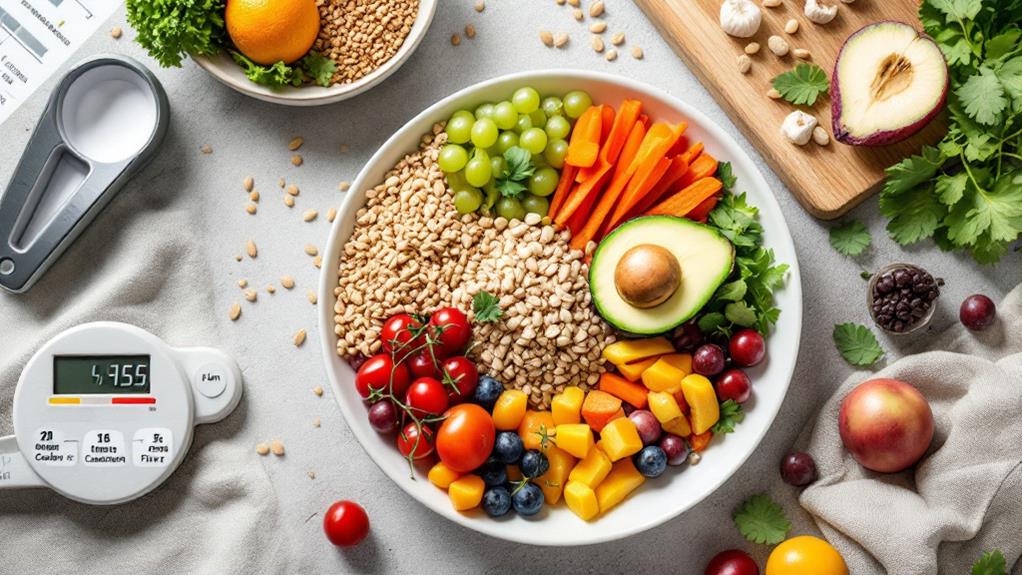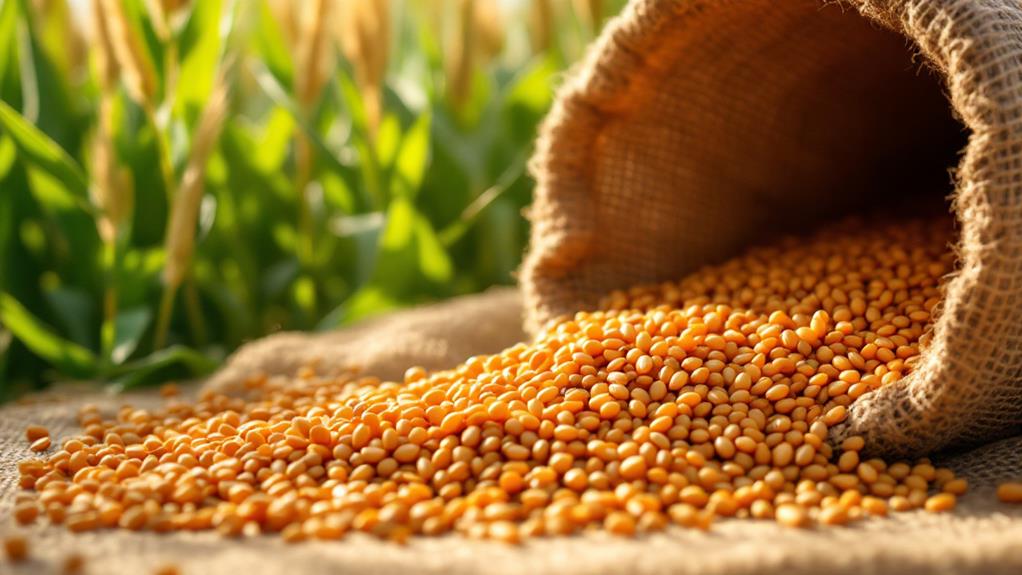What Is the Best Carb-Fiber Ratio for Losing Weight?

For losing weight, focus on maintaining a carb-to-fiber ratio of 10:1 or lower. Prioritize unprocessed, whole foods like fruits, vegetables, whole grains, and legumes, which naturally have this favorable ratio. This approach helps manage hunger and supports digestive health, making weight loss more achievable. High-fiber foods increase satiety, reduce temptation for unhealthy snacks, and align with the recommended daily fiber intake of 25-30 grams. Avoid processed foods with high carb-to-fiber ratios as they often lead to overeating. If you're curious about how adjusting this ratio can aid your weight management process, there's more to uncover.
Understanding Carbs and Fiber
When starting a weight loss expedition, understanding carbs and fiber is crucial. Carbohydrates are a major source of energy, but not all carbs are created equal. The key to effective weight loss lies in the carb-to-fiber ratio. Whole foods like fruits, vegetables, whole grains, and legumes typically boast a low carbohydrate-to-fiber ratio, making them fantastic choices. These foods not only support your weight loss goals but also improve your health by providing critical nutrients and regulating your appetite.
On the other hand, processed foods often have high carb-to-fiber ratios, which can lead to overeating. They lack the nutritional value that whole foods offer, making it harder to manage your calorie intake. For ideal weight management, aim for a carbohydrate-to-fiber ratio of 10:1 or lower. This approach helps keep you full longer, reducing the likelihood of consuming extra calories.
To optimize your efforts, increase your fiber intake to the recommended daily amount of 25-30 grams. This will aid in controlling your appetite and support healthy weight management. Online calculators can help you determine the carb-to-fiber ratios of different foods, guiding you toward better choices.
Importance of Fiber in Weight Loss
Fiber plays an important role in weight loss, offering numerous benefits that can help you achieve your goals. By focusing on your fiber intake, you can improve your chances of success. Aiming for a carb-to-fiber ratio of 10:1 or lower promotes satiety, making it easier to regulate hunger and maintain a caloric deficit. High-fiber foods like whole grains, fruits, and vegetables are not only packed with vital nutrients but also act as an appetite suppressant. They help in regulating blood sugar levels, which is critical for effective weight management.
A recommended daily fiber intake of 25-30 grams can greatly impact your weight loss progress. Unfortunately, only 5% of Americans reach this target. Incorporating diverse types of fiber into your diet supports gut health, enhancing your metabolic processes. This can further aid in weight loss efforts by stimulating gut hormones that control hunger and delay stomach emptying.
Pairing fiber-rich foods with healthy fats can also enhance your weight loss strategy. The combination helps stabilize your energy levels and prevents cravings, making it easier to stick to your dietary goals. Emphasizing fiber in your diet is a strategic move towards achieving sustainable weight loss.
Carb-Fiber Ratio Recommendations

Achieving the right carbohydrate-to-fiber ratio is vital for effective weight management. By focusing on a 10-to-1 or lower ratio, you guarantee that for every 10 grams of carbohydrates, there's at least 1 gram of dietary fiber. This ratio supports not only weight loss but also peak health. Whole foods like fruits, vegetables, grains, and legumes naturally have lower carbohydrate-to-fiber ratios, making them ideal for anyone looking to shed extra pounds. These high-fiber foods are important since only 5% of Americans meet the recommended fiber intake of 25-30 grams daily.
Incorporating more of these foods into your diet can reduce calories from less healthy options. Products that stick to this carb-fiber ratio typically have lower sugar, sodium, and trans fats, promoting healthy dietary choices. To achieve your weight loss goals, gradually increase your fiber intake and monitor how your body responds. This approach helps you determine your ideal carb-fiber ratio while supporting digestive health. Remember, focusing on this balance means you're not just counting calories but making choices that contribute to long-term health and sustainable weight management. Prioritizing high-fiber foods will set you on the right path.
Choosing the Right Carbs
To effectively choose the right carbohydrates, focus on whole, unprocessed options that naturally have a lower carb-to-fiber ratio. Foods like fruits, vegetables, whole grains, and legumes are excellent choices for weight loss. These high-fiber foods not only fill you up but also help regulate blood sugar, enhancing general health. When you prioritize whole foods, you're making healthy choices that support satiety and digestive health.
Avoid processed foods that are often loaded with refined carbohydrates and lack sufficient fiber. These foods can lead to weight gain and disrupt your weight management goals. Instead, aim for a carbohydrate-to-fiber ratio of 10:1 or lower. For example, a roll containing 23 grams of carbs alongside 5 grams of fiber fits the bill perfectly for promoting satiety and keeping blood sugar levels stable.
Incorporating these high-fiber foods into your diet can aid in reducing hunger and improving digestive health, both essential for effective weight loss. By choosing whole foods over processed ones, you're setting yourself up for success. Remember, the right carbs can make a significant difference in your path toward a healthier lifestyle.
Personalizing Your Diet

Crafting a diet that works best for you involves understanding your specific carbohydrate and fiber needs, where the ideal carb-to-fiber ratio is 10:1 or lower. Personalizing your diet means paying attention to your carbohydrate intake, considering factors like activity level and metabolic health. Your unique response to different fiber types can greatly impact your path toward ideal health and weight management.
To tailor your diet effectively, start by gradually introducing high-fiber foods, especially if you have sensitive digestion. This approach allows your body to adapt smoothly, ensuring a more comfortable change. Utilizing online calculators can also be a useful tool in identifying foods with favorable carb-to-fiber ratios, helping you make informed dietary choices.
Monitoring how your body reacts to distinct high-fiber foods is essential for developing a sustainable eating plan. This personalized approach not only aligns with your weight loss goals but also supports holistic metabolic health. By focusing on a diet that considers your individual needs and responses, you're setting yourself up for a more successful weight management path. Remember, achieving the right balance in your diet is key to long-term success.
Tips for Sustainable Weight Loss
Focusing on a well-balanced diet is vital for sustainable weight loss. Start by aiming for a carbohydrate-to-fiber ratio of 10:1 or lower, which can help keep you full and aid in weight management. Prioritize high-fiber foods such as beans, lentils, whole grains, fruits, and vegetables to reach the daily fiber intake of 25-30 grams. This approach not only improves satiety but also helps elevate diet quality by reducing reliance on processed options.
To make your weight loss experience successful, gradually reduce carbohydrate intake while focusing on nutrient-dense sources. This shift can help minimize cravings and maintain your energy levels. Meal planning becomes significant here. By prioritizing whole foods, you'll find it easier to stick to your dietary goals and see long-term results.
Additionally, monitor your individual response to high-fiber foods. Everyone's digestion is unique, and finding what works best for you guarantees satisfaction and adherence to your plan. Remember, sustainable weight loss is about making informed choices and adjustments that suit your lifestyle. With thoughtful meal planning and a focus on quality nutrients, you can achieve a balanced approach to weight management.




